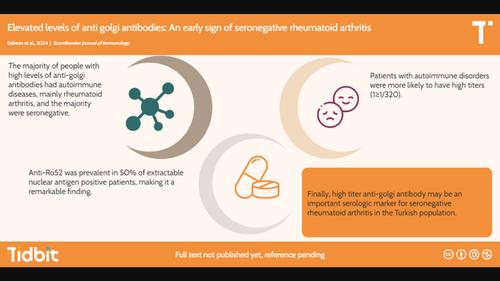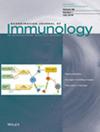Elevated levels of anti‐Golgi antibodies: An early sign of seronegative rheumatoid arthritis
IF 4.1
4区 医学
Q2 IMMUNOLOGY
引用次数: 0
Abstract
Anti‐Golgi antibodies are uncommon antibodies that exhibit specific, polarized cytoplasmic staining on the Hep‐2 substrate. The objective of our study was to identify the clinical and laboratory features associated with anti‐Golgi antibodies. We examined 4.5 years of data from a Turkish tertiary hospital in this retrospective cohort analysis. The indirect immunofluorescence staining patterns, antinuclear antibody (ANA) titres and clinical data of all patients were obtained from the hospital record system. A total of 146,055 ANAs were detected, of which 224 patients (0.15%) exhibited anti‐Golgi antibody staining. In total, 39.4% of diagnosed patients had autoimmune diseases (AIDs). Of the AIDs, 26 (46.4%) were rheumatoid arthritis (RA). This is a very high rate and another remarkable point is that 17 (65.3%) of these patients had seronegative RA. High‐titre results (1 ≥ 1/320) were more common in patients with AID. Anti‐Ro52 was prevalent in 50% of extractable nuclear antigen (ENA)‐positive patients, making it a remarkable finding. The majority of individuals with high‐titre anti‐Golgi antibodies had AID, particularly RA. The majority of these patients also tested negative for anti‐cyclic citrullinated peptide (anti‐CCP) and rheumatoid factor (RF). Finally, high‐titre anti‐Golgi antibodies may be an important serologic marker for seronegative RA in the Turkish population.

抗高尔基体抗体水平升高:血清阴性类风湿性关节炎的早期征兆
抗高尔基体抗体是一种不常见的抗体,它在 Hep-2 基质上表现出特异性、极化的细胞质染色。我们的研究旨在确定与抗高尔基体抗体相关的临床和实验室特征。在这项回顾性队列分析中,我们研究了一家土耳其三级医院 4.5 年的数据。所有患者的间接免疫荧光染色模式、抗核抗体(ANA)滴度和临床数据均来自医院记录系统。共检测出 146,055 个 ANA,其中 224 名患者(0.15%)表现出抗高尔基体抗体染色。共有 39.4% 的确诊患者患有自身免疫性疾病(AID)。其中,26 例(46.4%)为类风湿性关节炎(RA)。这是一个非常高的比例,另一个值得注意的问题是,这些患者中有 17 人(65.3%)血清阴性 RA。高滴度结果(1 ≥ 1/320)在 AID 患者中更为常见。50%的可提取核抗原(ENA)阳性患者普遍存在抗 Ro52,这是一个显著的发现。大多数高滴度抗高尔基体抗体患者都患有 AID,尤其是 RA。大多数患者的抗环瓜氨酸肽(anti-CCP)和类风湿因子(RF)检测结果也呈阴性。最后,高滴度抗高尔基体抗体可能是土耳其人群中血清阴性 RA 的重要血清学标志。
本文章由计算机程序翻译,如有差异,请以英文原文为准。
求助全文
约1分钟内获得全文
求助全文
来源期刊
CiteScore
7.70
自引率
5.40%
发文量
109
审稿时长
1 months
期刊介绍:
This peer-reviewed international journal publishes original articles and reviews on all aspects of basic, translational and clinical immunology. The journal aims to provide high quality service to authors, and high quality articles for readers.
The journal accepts for publication material from investigators all over the world, which makes a significant contribution to basic, translational and clinical immunology.

 求助内容:
求助内容: 应助结果提醒方式:
应助结果提醒方式:


